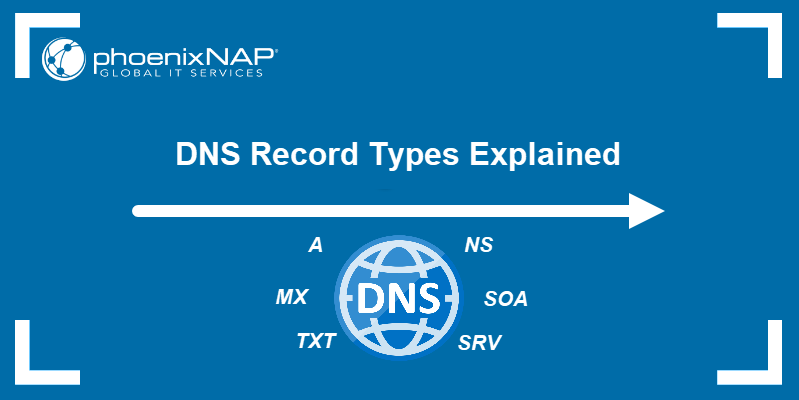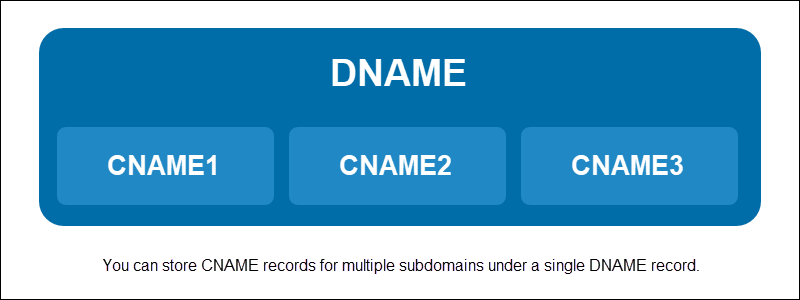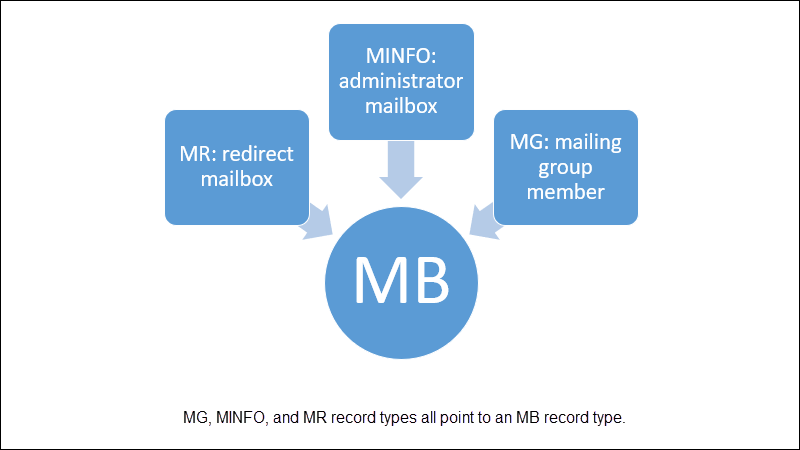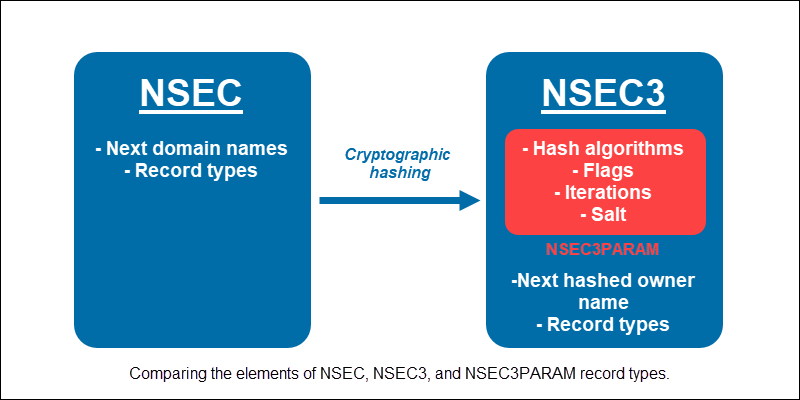What record is a mapping of an IP address to a hostname?
Introduction
DNS records or zone files store information about domains. They consist of a series of text files written in the DNS syntax and are stored on DNS servers.
In this tutorial, we accept you through a comprehensive alphabetical list of DNS tape types, explaining how they work, and provide examples and use cases.

A Record
A (accost) records are one of the most basic and usually used DNS record types. They interpret domain names and store them equally IP addresses. A records can only concord IPv4 addresses.
An case of an A record is:
| Domain proper noun: | Record type: | Value: | TTL |
| example-website.com @ | A | 192.0.0.1 | 14400 |
In the example above, the record is fabricated up of the following elements:
- Domain name: Contains the domain proper name of the website. The "@" symbol indicates that the record contains the root domain name.
- Record type: Indicates the usage of an A record type.
- Value: Contains the IP address associated with the domain name.
- TTL: Lists the record'due south TTL (Time to Live) in seconds. The default value is 14400, which means the tape expires subsequently 14400 seconds (240 minutes).
AAAA Record
AAAA records work the aforementioned as A records in that they store IP addresses connected to domain names. The only difference is that AAAA records agree IPv6 addresses.
AFSDB Record
AFSDB records connect a domain name to an AFS (Andrew File System) number. This record type is commonly used to contact AFS cells exterior the client'south local domain.
An AFSDB record case is:
| Address: | TTL: | Cyberspace type: | Record type: | Service subtype: | AFS jail cell server: |
| example-website.com | 14400 | IN | ASFDB | 1 | database01.example.com |
The example above contains the following elements:
- Address: Location of the AFSDB record.
- TTL: Time until the tape expires.
- Internet blazon: Indicates that the record is on the Internet.
- Record type: Indicates that this is an AFSDB record.
- Service subtype: Can either be 1 for an AFS volume location server or ii for a DCE authenticated server.
- AFS jail cell server: The canonical database hostname.
ATMA Record
An ATMA record maps a domain name to an ATM (Asynchronous Transfer Mode) address, expressed in either Due east.164 (decimal) or NSAP (hexadecimal) format. ATMA record entries apply the following elements:
| Host name: | Domain proper name: | Format: | Value: |
| Examplehost | example-website.com | E164 | 47.0091810000000060705A8F01.0060705A8F01.00 |
In the instance above:
- Host name: A unmarried-part name for the ATM host, written without periods (".").
- Domain proper name: The domain name you desire to map to an ATM address.
- Format: Tin be E164 or NSAP.
- Value: The ATM address mapped to the hostname.
CAA Record
CAA records permit domain owners to determine which document authorities can consequence certificates to that domain and all its subdomains. If there is no CAA record, anyone can issue certificates to the domain.
| Domain name: | Tape type: | Flag: | Tag: | CA: |
| case-webisite.com | CAA | 0 | event | "caa-domain.com" |
The CAA record case above contains the following elements:
- Domain name: The name of the domain that is being certified.
- Record type: Indicates that this is a CAA record.
- Flag: Can be either i (critical) or 0 (non-critical). A critical flag ways the certificate authority cannot use the CAA record if it doesn't understand the property. A non-critical flag means it can use the CAA record regardless of whether it understands the belongings.
- Tag: The 3 tag options are issue (authorized to issue a single certificate), issuewild (authorized to issue a wildcard certificate), and iodef (specifies a URL for reporting policy violations).
- CA: The certification authority that tin issue certificates for the domain in question.
CERT Record
CERT records provide a infinite for storing certificates and related certificate revocation lists (CRL). The certificates can verify the authenticity of sending and receiving parties, while CRLs identify unauthorized parties.
CERT records contain the following information fields:
- Tape type: Identifies the record as CERT.
- TTL: Time until record expires.
- Host: The domain name that is being certified.
- Type: Defines the type of certificate/CRL used.
- Key tag: A numeric value with the range of 0-65535, used to identify the CERT record.
- Algorithm: Identifies the algorithm used to produce the certificate/CRL.
- Points to: Base 64 encoded string.
CNAME Record
A CNAME (canonical name) record is used instead of an A record if a domain is an alias for some other domain. Considering of this, all CNAME records point to a domain instead of an IP address.
For case, in a domain called alias-domain.com which works as an alias for existent-domain.com, a CNAME tape for would await like this:
| Domain name: | Tape type: | Value: | TTL |
| alias-domain.com @ | CNAME | real-domain.com | 14400 |
This record contains:
- Domain name: Contains the allonym domain proper name. The "@" symbol shows that this is a root domain name.
- Record type: Shows that this is a CNAME record.
- Value: Contains the real domain proper name that the alias domain is pointing to.
- TTL: Time left until the record expires.
CNAME records usually contain subdomains that signal to a domain's A or AAAA record. This prevents having to create an actress A or AAAA record for each subdomain.
It is non recommended to have CNAME records pointing to other CNAME records, as this creates unnecessary steps to the DNS lookup process.
DHCID Tape
DHCID records shop DHCP (Dynamic Host Configuration Protocol) information. DHCP servers and clients generally create them through dynamic updates.
DNAME Record
DNAME records are used to create an allonym for every subdomain of a domain. They are similar to CNAME records, with the main difference being that CNAME can just store a single alias domain without any subdomains.

DNSKEY Record
DNSKEY records hold public data keys used to verify DNSSEC signatures. An case of a DNSKEY record might look like:
| Host: | TTL: | Record form: | Record type: | Flags: | Protocol: | Algorithm: | Public cardinal: |
| wxample-website.com | 14400 | IN | DNSKEY | 257 | 3 | 13 | ZhCa3rGLofZcndFN2aVd== |
In the example higher up:
- Host: Contains the domain name of the key holder. Domain names catastrophe with a menstruum do non suspend the origin to the characterization.
- TTL: Time left until the tape expires.
- Record form: Can exist IN (default), CH (used for querying DNS server versions), or HS (uses DNS functionality to provide admission to databases).
- Record type: Indicates that this is a DNSKEY tape.
- Flags: Contains "zone keys" for DNSSEC keys or "secure entry points" for simple keys.
- Protocol: Must contain the value of 3. All other values are invalid.
- Algorithm: Identifies the algorithm used to generate the public data primal.
- Public key: Contains the public data key.
DS Record
DS (delegation signer) records are used to secure delegations in DNSSEC. These records reference DNSKEY records in their sub-delegated zones.
DS records contain the following elements:
- Key tag: A numeric value that references a DNSKEY record.
- Algorithm: Identifies the algorithm used to generate the referenced DNSKEY record.
- Digest type: Specifies the cryptographic hash algorithm used to create the Digest value.
- Digest: A cryptographic hash value for the referenced DNSKEY record.
HINFO Tape
HINFO (host information) records store details about the hardware and operating system the host is using. Due to security concerns, simply sure application protocols use this data which is rarely stored on public servers.
A typical HINFO record contains:
- Host: The domain proper noun of the host.
- TTL: Time until tape expiration.
- Record class: Can exist IN (default), CH (used for querying DNS server versions), or HS (uses DNS functionality to provide admission to databases).
- Record type: Identifies the tape every bit HINFO.
- CPU: A curt clarification of the host's CPU.
- Operating system: The name of the operating system the host is using.
ISDN Tape
An ISDN tape maps the domain proper name to an ISDN (Integrated Services Digital Network) telephone number, using the ITU-T East.163/Eastward.164 international telephone numbering standards.
This record type tin contain an optional hexadecimal number as an ISDN sub-address.
MB, MG, MINFO, MR Records
MB, MG, MINFO, and MR records piece of work as an culling to the more than commonly used MX records:
- MB: Maps a mailbox to a host with an existing A tape.
- MG: Each MG record specifies a single mail group member. Each member must take a valid MB tape.
- MINFO: Points to an existing MB tape every bit a mailbox of an administrator.
- MR: Specifies a renamed mailbox. Forwards postal service to a new mailbox in an existing MB record.

MX Record
MX (mail exchange) records store instructions for directing emails to mail servers following the SMTP protocol. An MX tape might expect like:
| Domain proper name: | Record type: | Priority: | Value: | TTL: |
| example-website.com @ | MX | 10 | mail service.instance-website.com | 14400 |
In this example:
- Domain name: Specifies the domain name.
- Record type: Indicates an MX record.
- Priority: Specifies preference when delivering mail, with lower values having higher priority. If there is a failure to deliver, the mail service will be redirected to a lower-priority email server.
- Value: Specifies an email server for the domain name.
- TTL: Fourth dimension left to tape expiration.
Notation: An MX record tin only point to a proper name of an email server. This means that each referenced email server must likewise take a valid A record specifying its IP address.
NAPTR Record
An NS (nameserver) record indicates which server contains the DNS records for a given domain. Domains usually have several NS records pointing to main and backup nameservers for that domain.
A nameserver is a type of DNS server that contains all DNS records for a single domain.
| Domain proper name: | Record type: | Value: | TTL: |
| example-website.com @ | NS | nameserver.instance-server.com | 14400 |
The example in a higher place contains the following elements:
- Domain name: Contains the domain name.
- Record blazon: Shows that this is an NS record.
- Value: Specifies the nameserver for the provided domain.
- TTL: Fourth dimension until record expires.
NSAP Record
NSAP records map domain names to NSAP addresses, expressed in hexadecimal digits. NSAP addresses are similar to IP addresses and are used to identify equipment connected to an ATM network.
NSEC Record
An NSEC (next secure) record links to the side by side record in the DNSSEC sorting social club and lists the record types that be for that record's name. These records are ordinarily used as a role of DNSSEC validation to verify if a record proper noun exists or not.
NSEC records contain the following elements:
- Adjacent domain name: The proper noun of the side by side record in the DNSSEC sorting guild.
- Record types: A list of all the record types that exist for the specified record name.
NSEC3 Tape
NSEC3 (next secure version iii) records work the same equally NSEC records, except NSEC3 uses cryptographically hashed record names to forestall record names in a zone from being enumerated. These records incorporate the following elements:
- Hash algorithm: Specifies the algorithm for generating the cryptographically hashed record proper noun.
- Flags: Allows turning delegations on or off.
- Iterations: Indicates how many times the hash algorithm was applied.
- Salt: Salt value for the hash adding.
- Next Hashed Possessor Proper noun: The name of the next record in the hashed proper noun sorting club.
- Record types: Lists the record types that exist for the hashed record proper name.
NSEC3PARAM Record
An NSEC3PARAM (NSEC3 parameters) tape contains a list of parameters associated with an NSEC3 record. It determines which NSEC3 records to include as a response when DNSSEC requests a nonexistent record name or type.
NSEC3PARAM records include the Hash algorithm, Flags, Iterations, and Salt elements of an appropriate NSEC3 record.

PTR Record
PTR (pointer) records serve every bit an inverse of A or AAAA records. They map IP addresses to domain names and aid perform reverse DNS lookups.
PTR records store IP addresses in opposite:
- IPv4 addresses are saved with the segments in reverse lodge.
- IPv6 addresses are saved in the reverse order of hexadecimal digits.
RP Record
RP (responsible person) records store mailboxes of persons responsible for a given domain name. Boosted information, such every bit the responsible person'due south phone number or address, can be provided in a TXT record that the RP record maps to.
An example of an RP record:
| Domain name: | TTL: | Record class: | Tape type: | Mailbox: | TXT domain name: |
| example-website.com | 14400 | IN | RP | admin.example-website.com | moreinfo.examplewebsite.com |
In this example:
- Domain proper name: Provides a domain name.
- TTL: The number of seconds left until the record expires.
- Record class: Either IN (default), CH (used for querying DNS server versions), or HS (uses DNS functionality to provide access to databases).
- Record blazon: Identifies this tape as RP.
- Mailbox: Stores the post address of the person responsible for the domain proper noun.
- TXT domain name: Maps to a TXT record with boosted information.
RRSIG Record
An RRSIG record holds a DNSSEC signature for a set of 1 or more DNS records with the same name and type. These signatures can be verified with the public keys stored in DNSKEY records.
RRSIG records have the following elements:
- Type covered: DNS record type the stored signature covers.
- Algorithm: The cryptographic algorithm used to create the signature.
- Labels: The number of labels associated with the original RRSIG record name used to validate wildcards.
- Original TTL: The TTL value of the DNS record set.
- Signature expiration: Fourth dimension when the signature expires.
- Signature inception: Time when the signature was created.
- Key tag: A short numeric value for identifying the DNSKEY record that tin can validate the signature.
- Signer'southward proper name: The DNSKEY record that tin validate the signature.
- Signature: Contains the DNSSEC cryptographic signature.
RT Record
RT (route through) records are used to specify intermediate hosts that provide routing to the domain proper name stored in the record. Multiple intermediates can route to the same domain, with the lower preference value deciding who tries get-go.
Each intermediate host must likewise have a valid A record present.
SOA Tape
The SOA (get-go of authorisation) record holds important information nearly a domain or zone. These records are required by IETF standards and are an important chemical element of zone transfers.
SOA records detail the following zone properties:
- Name: Name of the primary DNS server for the zone. Each main server should besides take a matching NS tape.
- Record blazon: Indicates that this is an SOA record.
- MNAME: Specifies the principal nameserver for the zone.
- RNAME: The email address of the person responsible for the zone.
- Serial: The zone's serial number.
- Refresh: The number of seconds between checking for record updates.
- Retry: The number of seconds before asking an unresponsive primary nameserver for another update.
- Expire: How long to retry updating an unresponsive nameserver earlier stopping.
- TTL: Time until record expires.
SRV Record
SRV (service) records shop host and port information for cyberspace services, such as email or VoIP. Some internet protocols need valid SRV records to office.
SRV records concur the following information:
- Service: Symbolic name for a service.
- Protocol: Specifies if the service is using TCP or UDP protocols.
- Proper name: Stores a domain proper name.
- TTL: Time left until record expires.
- Course: Can contain IN (default), CH (used for querying DNS server versions), or HS (uses DNS functionality to provide access to databases).
- Blazon: Specifies tape type as SRV.
- Priority: Determines which server is looked at get-go, with lower values giving college priority.
- Weight: Determines which server is looked at first if more than 1 has the same priority value. College values give more priority.
- Port: The TCP or UDP port the service is running on.
- Target: The canonical hostname for the auto providing the service.
TLSA Tape
TLSA (Transport Layer Security Authentication) records store keys used in a domain's TLS servers. The names of TLSA records are made upwards of a port number, protocol proper name, and TLS server host proper noun.
These records detail certificate usage, selector, and matching blazon as numeric values with a range of 0-255 and certificate association data as a hexadecimal value.
TXT Record
TXT (text) records are used to store descriptive text. They are often used in combination with other tape types to provide additional data that doesn't fit the format of other records.
| Domain name: | Tape blazon: | Value: | TTL: |
| example-website.com @ | TXT | Instance text. | 14400 |
The example in a higher place shows a typical TXT record. It contains the following elements:
- Domain name: Specifies a domain name.
- Record type: Shows that this is a TXT record.
- Value: Stores a user-defined text cord.
- TTL: Time until record expires.
Note: Text strings in TXT records take a maximum length of 255 characters.
X25 Record
X25 records map domain names to a PSDN (Public Switched Data Network) address number following the X.121 international numbering plan.
Conclusion
After reading this commodity, you should take a basic understanding of the various DNS tape types. You can apply the guide as a reference and reminder when yous demand quick data on a tape type.
Was this commodity helpful?
Yes No
Source: https://phoenixnap.com/kb/dns-record-types
0 Response to "What record is a mapping of an IP address to a hostname?"
Post a Comment